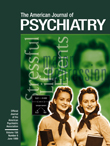Short Screening Scale for DSM-IV Posttraumatic Stress Disorder
Abstract
OBJECTIVE: The authors’ goal was to construct a short screening scale for DSM-IV posttraumatic stress disorder (PTSD). METHOD: They used data from the Detroit Area Survey of Trauma, which is a representative population sample of 2,181 subjects 18–45 years of age. Random digit dialing was used to select the sample, and a computer-assisted telephone interview was used to collect data on traumatic experiences and PTSD. Presence or absence of PTSD was assessed with a telephone-administered structured interview that closely followed the National Institute of Mental Health Diagnostic Interview Schedule for DSM-IV and the World Health Organization Composite International Diagnostic Interview, version 2.1. Best-subset regression analysis and receiver operating characteristic analysis were used to select a subset of items from the structured interview that most efficiently predicted PTSD as diagnosed in the full-length interview. RESULTS: A seven-symptom screening scale for PTSD was selected; five of the symptoms were from the avoidance and numbing group, and two were from the hyperarousal group. A score of 4 or greater on this scale defined positive cases of PTSD with a sensitivity of 80%, specificity of 97%, positive predictive value of 71%, and negative predictive value of 98%. CONCLUSIONS: The short screening scale is an efficient method to screen for PTSD in epidemiologic and clinical studies, given limitations on resources and burden on respondents.



